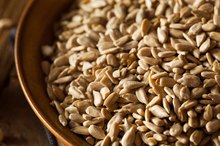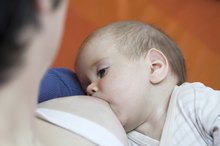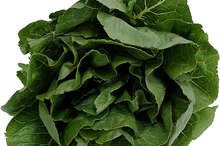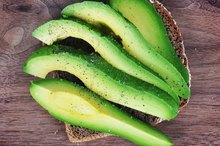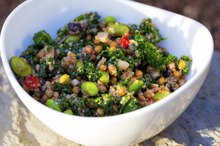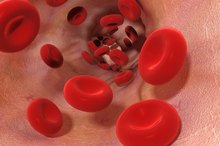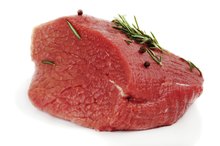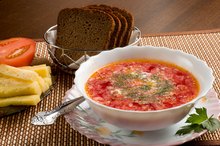What does fact checked mean?
At Healthfully, we strive to deliver objective content that is accurate and up-to-date. Our team periodically reviews articles in order to ensure content quality. The sources cited below consist of evidence from peer-reviewed journals, prominent medical organizations, academic associations, and government data.
The information contained on this site is for informational purposes only, and should not be used as a substitute for the advice of a professional health care provider. Please check with the appropriate physician regarding health questions and concerns. Although we strive to deliver accurate and up-to-date information, no guarantee to that effect is made.
List of Foods & Drinks High in Iron
Most people equate iron deficiency with anemia, but not getting enough iron in your diet affects all bodily functions. In addition to playing a role in assisting hemoglobin with carrying oxygen throughout your body, iron is also needed for the proper working of all your cells. Filling your diet with food rich in iron ensures you're getting what you need for overall better health. Consult your doctor if you're concerned about the iron in your diet.
Iron Needs Vary
Iron needs for premenopausal women are significantly higher than they are for men and post-menopausal women -- 18 milligrams per day vs. 8 milligrams per day. This is due to the increase in iron losses for women due to menstruation. Iron needs for pregnant women are even higher at 27 milligrams per day.
The average iron intake in the Western diet is about 6 to 7 milligrams per 1,000 calories, according to the University of California, Davis 1. While men may not have a hard time meeting their needs, women do.
- Iron needs for premenopausal women are significantly higher than they are for men and post-menopausal women -- 18 milligrams per day vs. 8 milligrams per day.
Heme Iron in Animal Proteins
Are Sunflower Seeds a Food High in Iron?
Learn More
Animal proteins contain heme iron, which the body easily absorbs. Oysters are a significant source of iron, meeting 44 percent of the daily value in a 3-ounce cooked portion. Sardines and beef bottom round are also good sources, meeting 11 percent of the daily value in a 3-ounce cooked portion.
You can also get more iron in your diet with other cuts of beef, as well as chicken, turkey, pork, other types of seafood and eggs.
- Animal proteins contain heme iron, which the body easily absorbs.
- Oysters are a significant source of iron, meeting 44 percent of the daily value in a 3-ounce cooked portion.
Nonheme Iron in Plant Proteins
Plants contain iron in nonheme form, which is not as easily absorbed as heme iron. In fact, iron needs for vegetarians are 1.8 milligrams higher than the recommended dietary allowances due to the decrease in iron availability.
Plant proteins include legumes such as beans, peas and lentils, nuts and seeds. One cup of white beans contains as much iron as a serving of oysters. Lentils and tofu are also rich in iron, meeting 17 percent of the daily value in a 1/2-cup portion. Kidney beans, chickpeas, cashews and pistachio nuts can also help you meet your iron needs.
Including vitamin C-rich foods, such as red or green peppers, broccoli or orange juice, with nonheme sources of iron helps improve your body's absorption 2.
- Plants contain iron in nonheme form, which is not as easily absorbed as heme iron.
- Including vitamin C-rich foods, such as red or green peppers, broccoli or orange juice, with nonheme sources of iron helps improve your body's absorption 2.
Iron-Rich Vegetables, Grains and Fruit
How Much Iron a Mom Needs While Breastfeeding?
Learn More
You can get iron in a variety of different vegetables, grains and fruits. Like the plant proteins, these foods also contain nonheme iron.
One serving of whole-grain fortified breakfast cereal may help you meet 100 percent of your daily iron needs. Cooked spinach is also rich in iron, meeting 17 percent of the daily value per 1/2 cup. Canned tomatoes, green peas, raisins, figs, and whole-wheat bread are rich in iron as well.
- You can get iron in a variety of different vegetables, grains and fruits.
- Cooked spinach is also rich in iron, meeting 17 percent of the daily value per 1/2 cup.
Related Articles
References
- University of California, Davis: Iron and Iron Deficiency Anemia
- American Red Cross: Iron Rich Foods
- Office of Dietary Supplements: Iron
- Office of Dietary Supplements: Vitamin C
- Beard, J. L., Dawson, H., & Piñero, D. J. (1996). Iron metabolism: a comprehensive review. Nutrition Reviews, 54(10), 295-317.
- Trumbo, P., Yates, A. A., Schlicker, S., & Poos, M. (2001). Dietary reference intakes: Vitamin A, vitamin K, arsenic, boron, chromium, copper, iodine, iron, manganese, molybdenum, nickel, silicon, vanadium, and zinc. Journal of the Academy of Nutrition and Dietetics, 101(3), 294.
- Allen, L. H. (2000). Anemia and iron deficiency: effects on pregnancy outcome. The American Journal of Clinical Nutrition, 71(5), 1280s-1284s.
- Drukker, L., Hants, Y., Farkash, R., Ruchlemer, R., Samueloff, A., & GrisaruâGranovsky, S. (2015). Iron deficiency anemia at admission for labor and delivery is associated with an increased risk for Cesarean section and adverse maternal and neonatal outcomes. Transfusion, 55(12), 2799-2806.
- Miller, J. L. (2013). Iron deficiency anemia: a common and curable disease. Cold Spring Harbor Perspectives in Medicine, 3(7), a011866.
- Percy, L., Mansour, D., & Fraser, I. (2017). Iron deficiency and iron deficiency anaemia in women. Best Practice & Research Clinical Obstetrics & Gynaecology, 40, 55-67.
- Telford, R. D., Sly, G. J., Hahn, A. G., Cunningham, R. B., Bryant, C., & Smith, J. A. (2003). Footstrike is the major cause of hemolysis during running. Journal of Applied Physiology, 94(1), 38-42.
- Zoller, H., & Vogel, W. (2004). Iron supplementation in athletesâfirst do no harm. Nutrition, 20(7), 615-619.
- Collings, R., Harvey, L. J., Hooper, L., Hurst, R., Brown, T. J., Ansett, J., ... & Fairweather-Tait, S. J. (2013). The absorption of iron from whole diets: a systematic review. The American Journal of Clinical Nutrition, ajcn-050609.
Writer Bio
Jill Corleone is a registered dietitian and health coach who has been writing and lecturing on diet and health for more than 15 years. Her work has been featured on the Huffington Post, Diabetes Self-Management and in the book "Noninvasive Mechanical Ventilation," edited by John R. Bach, M.D. Corleone holds a Bachelor of Science in nutrition.
